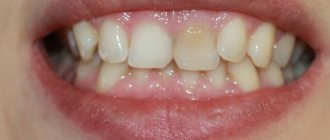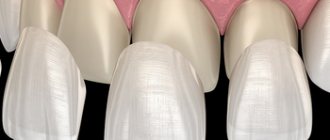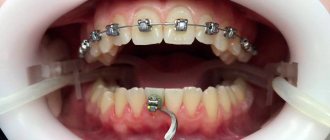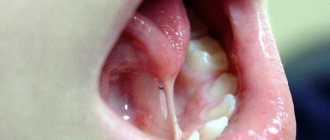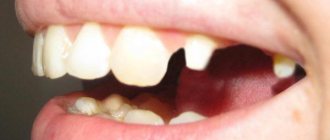Metal-ceramic crowns are a reliable, long-term way to restore teeth. Although cermet material is very durable, it is not eternal. The patient sometimes encounters cracks, abrasions, chips or scratches on the surface of the crown. Damage to ceramic cladding is caused by:
- High chewing load (too hard food);
- violation of the manufacturing technology of a crown or prosthesis;
- incompatibility of frame base and cladding materials;
- violation of installation technology (long prosthesis, incorrectly selected abutment teeth);
- bite problems;
- bruxism (teeth grinding).
Damage to the ceramic lining disrupts the aesthetics of the prosthetic structure and its functionality. But this is no reason to despair. The damaged surface can be restored, returning the crown to its original appearance. The main method of restoring a chipped crown without removing it is the restoration of metal ceramics with a light-curing composite.
Types of crowns
Metal-ceramic crowns differ in the metal alloy from which the frame is made, the manufacturing method, and service life. In most cases, an alloy of base metals (chromium-nickel, chromium-cobalt) is used to make the frame. They are durable, reliable, and not subject to deformation. This is a budget option that, with proper care, will last 8-10 years.
Often the frame is made of an alloy of gold with palladium, platinum, and silver. These are hypoallergenic materials that have an antibacterial effect, containing up to 80-90% gold. Ceramic-lined structures look natural, so they are perfect for installation in the smile area. Service life – up to 12-15 years.
When it comes to prosthetics on implants, the base of the crown is made of titanium. The material is compatible with body tissues, does not cause allergies, and eliminates the development of galvanic effect (galvanosis). Such structures will last 15 years or more.
According to manufacturing technology, metal-ceramic crowns can be cast or milled. Ceramic mass is applied layer by layer to the finished frame, made by any method, firing each subsequent layer. Modern dentistry has solved the problem of the “blue” strip around the gums, which made the installation of metal-ceramic structures on the front teeth undesirable. Today, crowns with shoulder mass are used - the manufacturing technology provides for a special ledge, which is also lined with ceramics to avoid oxidation of the metal upon contact with the gum. This makes the prosthesis aesthetic, allowing you to restore incisors and canines.
Why did the metal-ceramic crown break?
In fact, the carelessness and negligence of the patient is far from the primary reason for the chipping of metal-ceramics. The crown can also chip:
- If the metal alloy and the ceramic mass do not match in thermal expansion;
- If the patient suffers from bruxism (involuntary creaking and grinding of teeth);
- If some foreign object gets between the crown and the stump of the tooth;
- If the tooth was initially modeled incorrectly;
- If the ceramic veneer was fired at the wrong temperature;
- If there were holes or chips in the frame.
Restoration methods
Shallow cracks and abrasions are eliminated by polishing the ceramic surface. Small chips are restored using light-curing composites. This is the most common way to restore an orthopedic system without replacing it. Restoration of metal ceramics includes the following stages:
- The extension area is isolated from moisture;
- grind the chipped area to improve the adhesion of materials;
- after drying, a composite material is applied to the defect layer by layer, each layer is illuminated with a UV lamp;
- Upon completion of the extension, the area is ground and polished to give a natural shine, the appearance of a crown.
Repairing a metal-ceramic chip takes about 30 minutes. Restoration extends the life of the prosthesis, restores the original appearance, and returns the aesthetics and functionality of the dentition. However, repair of chips on metal ceramics is carried out without a guarantee, since there are many negative factors that affect the service life of the restoration.
If a metal-ceramic crown breaks off, there is no need to throw away the fragment. It is likely that the doctor will be able to use it to restore the integrity of the lining. In case of extensive damage, when a significant part of the metal is exposed, or chips of the lining of the contact surfaces, another option is required - replacing the damaged structure with a new one.
Tooth perforation: what to do and should you panic?
Perforation (of the bottom, walls of the tooth or root canal) is a complication that can occur during endodontic treatment when working with burs, hand or machine tools for mechanical treatment of the canal, as well as when installing pins and inlays, and representing a pathological (unnatural) message (hole) with supporting surrounding tissues (bone, gums, periodontal ligament).
Types of perforations
By localization level:
- Crown part of the tooth
- Walls of the tooth crown
- In the area of furcation (furcation is the junction of the roots of the tooth in multi-rooted teeth
Root part of the tooth (canal)
- Wellhead
- Middle part
- Apical part
By time of occurrence:
- Fresh:
which arise during the treatment process and are immediately covered with special materials - Old:
after the occurrence of which no measures were taken to eliminate them, which worsens the prognosis and can lead to additional complications (infection, fracture, crack)
By type of perforation:
- Spot
- Strip perforations (ribbon, longitudinal)
Possible causes of perforation
Let's now see why this complication may occur.
Perforations are most often associated with doctor errors (careless work with burs, ignorance of anatomy and lack of experience, incorrect use of instruments for mechanical processing of canals, etc.). Also important are dental dystopia (improper position in the dentition), complex anatomy of the root canal system, calcification of the dental cavity and obliteration of canals.
Very rarely, the cause may be injury or advanced caries.
Let's look at each type of perforation in more detail.
Perforation of the tooth wall
most often occur when working with burs when creating access to the root canals and deviation from the axis of the tooth.
Perforations in the furcation area
arise as a result of excessive preparation in the process of creating access to the root canals; when installing pins, when they deviate from the course of the channel; when searching for the mouth (entrance to the canal) in case of obliteration (obliteration or calcification - a process in which replacement dentin is deposited, which tightly closes the lumen of the canal).
Perforation of the root canal wall
can occur with a complex anatomical structure of the canals (bends, branching canals), with excessive pressure on the instruments, incorrect direction of insertion of the instrument, with errors in the initial stages of work (creating steps, blocking the canal lumen with sawdust with insufficient irrigation), when preparing the canal for the pin, when trying to remove broken fragments of instruments, as well as during repeated endodontic treatment.
Strip perforations
usually occur when preparing a channel for a pin or when trying to remove broken fragments of instruments. In this case, the canal wall seems to be “worn” and an elongated defect is formed.
How to diagnose perforation?
If perforation occurs during treatment, the patient may feel pain, and the doctor will visually see bleeding from the perforation area.
We can see old perforations on x-rays and when analyzing a computed tomogram. For example, an unfilled or underfilled canal, periapical lesions, excessive release of filling material in the root wall area, deviation of the filling material from the course of the canal when the boundaries of the installed pin cross the boundaries of the canal. All this can help to suspect the presence of perforation.
We can also visualize perforation using an operating microscope during repeated endodontic treatment or diagnostic preparation.
Symptoms of perforation
Fresh perforations are usually not accompanied by symptoms, but pain may occur when they occur.
Old perforations are also usually asymptomatic.
There may be periodic discomfort when biting or minor pain.
Treatment of perforation
Treatment tactics depend on many factors:
- In which area did the perforation occur: the most favorable prognosis are defects of the apical part, because, as a rule, they are not infected. The most unfavorable ones are the furcation and estuarine ones, because the zone of maximum infection is located in this part.
- Fresh or old perforation
- Is there apical periodontitis or not?
- At what stage did the perforation occur: at the initial or final stage? Defects that occur at the beginning of work have a greater risk of infection and therefore require additional medical treatment
- Perforation size
If this perforation is fresh, then after stopping the bleeding it must be immediately closed with MTA-based material. This is a special cement (mineral trioxide aggregate), which has biocompatibility, a chemical bond with dentin, a high degree of sealing and stimulates the formation of cement-like tissue, which is especially important for us when closing such defects.
If this is a small root canal perforation, it can be closed by filling the canal with a bioceramic sealer.
Old perforations, as a rule, always become infected, therefore, before closing them, it is necessary to clean the edges of the perforation: mechanical removal of infected dentin and medicinal treatment (in essence, this is a kind of “wound”, which requires the removal of “contaminated” tissues before applying a medicinal ointment).
Thus, the faster the perforation is closed, the better, because the risk of damage to periodontal tissue (ligament and bone tissue), which leads to lesions that are difficult to treat, is reduced.
But if you leave the problem without treatment, you can get complications, such as:
- Infection and development of apical periodontitis
- Root cracks
- Root fractures
After treatment of a tooth with perforation, it is subject to dynamic observation and radiological control.
Let's summarize: creating a perforation in the vast majority of cases is a doctor's mistake, despite modern technologies and tools. Such mistakes happen quite often, and it is rare that a doctor has never perforated a single tooth in his entire practice. No one is immune from this error, but if you follow a number of certain rules, you can reduce the risk of perforation to a minimum.
How is a crown replaced?
Installation of a dental crown is a non-removable prosthetic method. This means that the patient cannot remove the structure on his own. This is done exclusively in a clinical setting. After the specialist has decided to replace the structure with a new one, in order to facilitate the removal of the damaged crown, it is carefully sawed or the cementing composition is destroyed with ultrasound. In this case, the crown can be removed without damaging it.
After removing the structure, the dentist assesses the condition of the supporting tooth and, if necessary, treats it. Upon completion of treatment and filling, repeated prosthetics are performed. That is, dental impressions are taken again, a prosthesis is made in the laboratory, and after fitting, the finished structure is fixed with cement.
The choice of material for a new dental crown depends on the clinical picture and the wishes of the patient. Often, when it is necessary to replace an old structure with a new one, the patient wants to improve the aesthetics by changing metal ceramics to solid ceramics or zirconium dioxide.
Prevention of cracks in crown enamel
The best preventive measures are a balanced diet and careful treatment of your teeth. You should not eat hot and cold foods at the same time. This alternation leads to cracking of the enamel.
To maintain dental health, it is recommended to take dietary supplements. For example, a complex of calcium citrate and vitamin D. When brushing your teeth, you should give preference to medium-hard brushes and non-abrasive pastes. After eating, it is advisable to use dental floss.
To preserve your dental health, you need to undergo a preventive examination at the clinic twice a year and listen to the recommendations of dentists.
Materials
In dentistry, the following are used to restore a tooth crown:
- Metal plastic, fragile structures. As a rule, they are used as temporary dentures or for implantation, if artificial teeth cannot be overloaded.
- Metal ceramics (metal base with ceramic coating). The likelihood of chipping on such crowns is lower than in the previous case, but with improper care, such structures can be destroyed.
- Ceramics. Under heavy load, structures can crumble and chips occur.
- Zirconium or aluminum dioxide. When using prosthetics with these crowns, the risk of various defects appearing during wear is minimized.
Metal ceramics
Metal ceramics represent a compromise between strength, aesthetics and cost. The structures are cast from metal alloys (mainly cobalt-nickel or cobalt-chromium) and can be either individual for each unit or pavement. In some cases, the frame may be made of titanium or precious materials.
A porcelain coating is applied over the metal body to match the patient's enamel color. The mass is applied manually, layer by layer, and during the manufacturing process, each layer is fired in an oven at high temperature. This technology is necessary to create additional strength of the product.
The disadvantage of metal-ceramics (as well as metal-plastic) is the need to grind down teeth and remove nerves to install a crown.
In addition, if the decorative layer is damaged, the metal base will be visible underneath it, which is significantly different from the appearance of other teeth.
This is interesting: New generation dentures: removable and fixed
Metal-plastic
Metal-plastic is made according to the same principle as metal-ceramics, with the difference that instead of porcelain, plastic acts as a facing material. It is cheaper than ceramics, but plastic has a number of disadvantages.
Plastic is capable of absorbing food particles during use, which can cause its surface to become stained and acquire an unpleasant odor.
In addition, the light transmittance of plastic differs from the enamel of real teeth much more than the same characteristic of porcelain, which reduces aesthetic indicators.
In addition, the problem of chipping decorative plastic coating is quite common.
Ceramics
Ceramic crowns are made from porcelain. They are created using high-temperature injection molding technology, which makes it possible to produce products of ideal shape and high strength.
Due to this technology, ceramic crowns do not require metal frames, although they are somewhat inferior in wear resistance to metal-ceramic structures.
Unlike metal-ceramics, porcelain crowns have a much more aesthetic appearance and stability.
The disadvantage of such products is the impossibility of manufacturing bridge structures (only individual dentures for the crown of teeth are made from ceramics). In addition, such products have a high cost.
Zirconium dioxide
Zirconium dioxide crowns are also ceramic-coated products. Zirconium dioxide is one of the most modern materials for the manufacture of dental crown prostheses.
The frame of zirconium crowns is very durable and has a natural color – white or close to the color of the patient’s enamel. A layer of sintered porcelain is applied on top of it.
This structure allows you to combine strength and high aesthetics. Zirconium crowns do not show through when exposed to direct color, which further increases their aesthetics.
How to avoid further chipping?
It should be remembered: although cermet is a durable material, its ceramic base can be damaged. Therefore, dentists do not recommend eating solid food that needs to be chewed; they advise you to give up the habit of gnawing on a pen or pencil, and not to hold small objects in your mouth, holding them between your teeth.
In addition, special attention should be paid to oral hygiene . Although plaque does not harm the crown itself, it can affect dental caries in the neighborhood.
It is necessary to visit the dentist approximately once every six months so that the doctor promptly notices microcracks or chips of the crown, checks the reliability of its fastening and removes food particles that may get between the gum and the crown.
You can install or restore a crown, as well as sign up for a preventive examination at the As-Stom clinic 597-05-05 or using the online application form .
Price
On average, the cost of restoring a chip on a metal-ceramic crown ranges from 2,500 to 4,500 rubles. Restoration using composite materials will cost approximately 3,000 rubles, and using solid inlays - from 4,000 rubles.
Re-polishing the restoration costs approximately 400 rubles, and making a new crown costs more than 10,000 rubles.
First of all, the price depends on the size and location of the damage. The qualifications of a specialist are of great importance. If the chip occurred as a result of an error by the dentist or dental technician, the patient does not pay for the repair.
The video presents a master class on intraoral repair of a prosthesis when the ceramic veneer is chipped.
Why does destruction occur?
Crowns can be destroyed for the following reasons:
- if the product was made of low-quality material;
- a person does not properly care for the oral cavity;
- in the presence of too heavy loads;
- if a person suffers from bruxism: teeth grinding.
How to extend the service life
After installing crowns, it is imperative to maintain oral hygiene. Brush your teeth at least 2 times a day, use floss, and purchase a toothpaste with a high degree of abrasiveness. Another mandatory requirement is to rinse your mouth after eating every time. And, of course, undergo regular inspections to ensure timely detection of damage. Thus, not only will your health be maintained, but time and money will also be saved.
In our dental clinic, doctors carefully select the material for making the crown and the design of the prosthesis. Thanks to the professionalism of the doctors, the crowns are installed in accordance with all requirements and fit tightly. It is violations of requirements and the lack of professionalism of some doctors that are a frequent reason for the destruction of the material. Therefore, you should choose only proven clinics for treatment.
Reviews
Most often, crowns are damaged after injury or due to improper dental care. Experts believe that it is necessary to restore chips as early as possible in order to avoid complete destruction of the product.
If you want to ask any questions about restoring the integrity of the crown or simply share your feedback, write them in the comments to this article.
Sources:
- https://www.adent.ru/vosstanovlenie-koronki-zuba
- https://pcvoice.ru/lechenie/restavraciya-koronok-zubah
- https://zubovv.ru/protezirovanie/nesemnyie-p/koronki-np/sposobyi-vosstanovleniya.html
- https://anZub.ru/protezirovanie/vosstanovlenie-koronkovojj-chasti-zuba/
- https://www.vash-dentist.ru/protezirovanie/nesemnyie-p/koronki-np/skol-keramiki-kak-ustranit-defekt.html
- https://medside.ru/shtiftyi-i-koronki
- https://www.tssdent.ru/vosstanovlenie-restavraciya-koronki/
